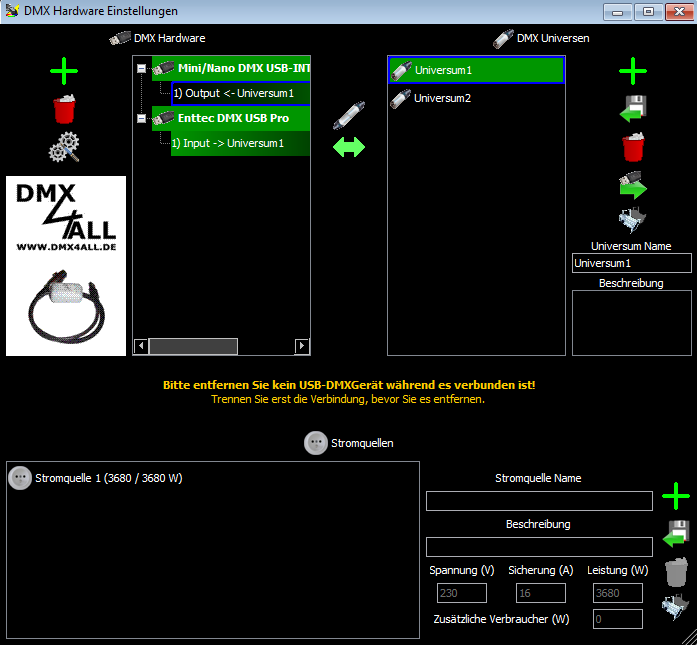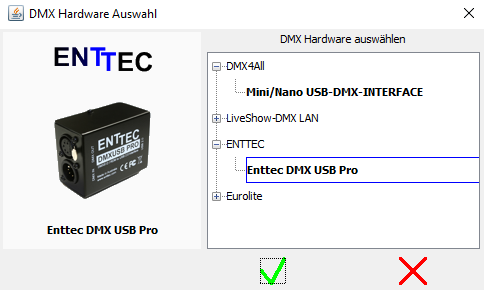
| The 'Select DMX Hardware' window opens, where you can select and add a DMX hardware interface. | |
| Deletes the selected DMX hardware interface | |
| Opens the configuration window for the selected hardware interface |

| Adds the selected DMX hardware interface. | |
| Closes the selection window without adding the hardware. |

| A new DMXUniversum is added | |
| Import an existing DMX universe - including all lamps and their lamp types A created project is not saved in a file, but every aspect of a project is stored in its own file. Among other things, all DMXUniversen used are stored in a file "projektname.lsu". The lamp types used are stored in the file "projektname.lsd". Both information, ie the DMXUniversen (+ lamps) and the lamp types are imported here. If your project already has the same universe, it will not be imported again. Attention: When creating a DMXUniversum, the universe is internally given a unique ID, this ID is used to identify the DMXUniversum. If you have created a project as a copy of another project, the DMXUniversen in both projects have the same ID. So you can not import the universe into the project! Imported elements are marked with a leading "*" in the name. |
|
| The selected DMXUniversum is deleted |
|
| The 'DMX Input Settings' window opens, here you can specify how a DMX input is to be used. | |
| Opens the stage view and the lamp filter is automatically set to the selected universe, so only the lamps that are connected to the selected universe are displayed. |
| The hardware output / input and the universe are not connected, With this button you can connect the two |
|
| The hardware output / input and the universe are connected, Use this button to disconnect the connection. |
 |
The universe is not connected either to an input or to an output of a DMX hardware interface. |
 |
The universe is connected to an input but no output of a DMX hardware interface. The DMXHarwareInterface is connected to the computer and the LiveShow software. |
 |
The universe is connected to an input but no output of a DMX hardware interface. The DMXHarwareInterface is NOT connected to the computer or the LiveShow software. |
 |
The universe is connected to an output but no input of a DMX hardware interface. The DMXHarwareInterface is connected to the computer and the LiveShow software. |
 |
The universe is connected to an output but no input of a DMX hardware interface. The DMXHarwareInterface is NOT connected to the computer or the LiveShow software. |
 |
The universe is connected to an input of a DMX hardware interface and an output of a DMX hardware interface. The DMXHarwareInterface, which has the input, is connected to the computer and the LiveShow software. The DMXHarwareInterface, which has the output, is connected to the computer and the LiveShow software. |
 |
The universe is connected to an input of a DMX hardware interface and an output of a DMX hardware interface. The DMXHarwareInterface that has the input is NOT connected to the computer and the LiveShow software. The DMXHarwareInterface, which has the output, is connected to the computer and the LiveShow software. |

| A new current source is added | |
| Import current sources from another project. A created project is not saved in a file, but every aspect of a project is stored in its own file. Among other things, all current sources are also stored in a file "projektname.lse". In the file selection, simply search within the files of a project with the suffix ".lse". |
|
| The selected current source is deleted | |
| Opens the stage view and the lamp filter is automatically set to the selected current source, so only the lamps connected to the selected current source are displayed. |
| current source name | Here you can specify the name of the current source |
| description | Here you can enter a description |
| voltage | The voltage in V (volts) of the current source |
| fuse | The fuse of the current source in A (Ampere) |
| power | The maximum electrical power in watts). This field is calculated automatically when you enter the voltage and the fuse. |
| additional consumers | Enter the total power in W (Watt) of all devices connected to this power source. Additional devices are e.g. Beamer, SoundMixer, PA, DMXSplitter, coffee machine, etc. |